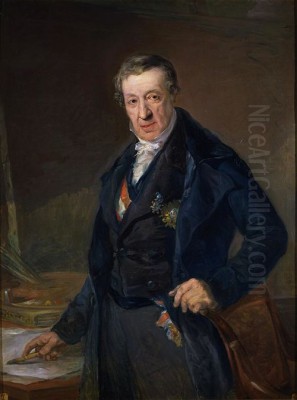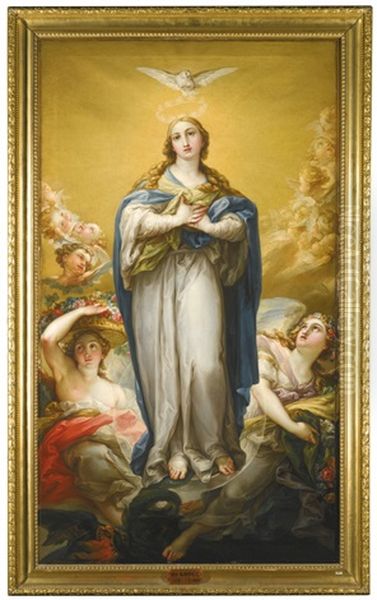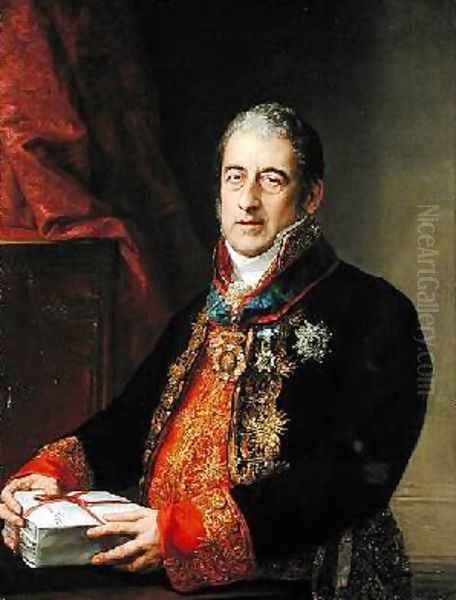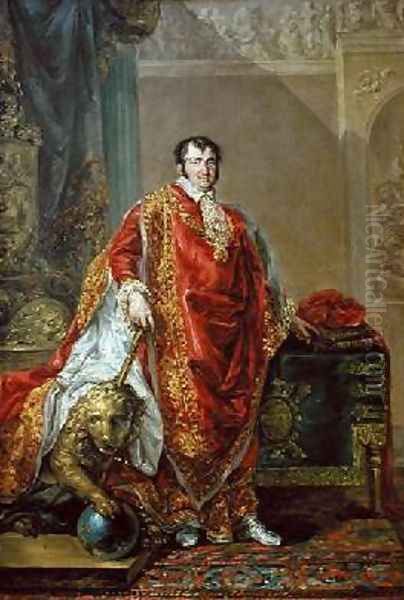
Vicente López y Portaña stands as a pivotal figure in the landscape of Spanish art during the late 18th and first half of the 19th centuries. Born in Valencia on September 19, 1772, and passing away in Madrid on July 22, 1850, his life spanned a period of profound political and artistic transformation in Spain. Renowned primarily as a portraitist, López y Portaña rose to become the favoured painter of the Spanish monarchy, succeeding the legendary Francisco Goya as First Court Painter. His prolific output and distinctive style, which elegantly blended Neoclassical precision with lingering Baroque sensibilities, defined official portraiture for decades and left an indelible mark on the art of his time.
Early Life and Artistic Awakening in Valencia
Vicente López y Portaña's journey into the world of art began in his vibrant hometown of Valencia. Showing artistic promise from a young age, he commenced his formal training around the age of thirteen. His education was nurtured at the prestigious Real Academia de Bellas Artes de San Carlos in Valencia, a key institution for artistic development in the region. Under the tutelage of Father Antonio Villanueva, a respected Franciscan friar and painter, López honed his foundational skills in drawing and painting.
His talent quickly became apparent. By the age of seventeen, in 1789, López achieved significant recognition by winning a first prize in painting from the Academy. Sources suggest this award may have been for a work depicting a biblical theme, possibly related to King Hezekiah, showcasing his early engagement with historical and religious subjects. This accolade was not merely an honour; it came with a crucial scholarship, enabling the young artist to further his studies in the nation's capital, Madrid. This move marked a critical step in his transition from a promising regional talent to an artist destined for the national stage.
Madrid Studies and Formative Influences

Arriving in Madrid around 1790, López enrolled in the Real Academia de Bellas Artes de San Fernando, the country's premier art institution. This period was instrumental in shaping his artistic direction, exposing him to the dominant styles and leading figures of Spanish art. He spent three years absorbing the lessons of the capital's art scene, studying under influential masters who represented the prevailing Neoclassical tastes.
Among his most significant mentors in Madrid were Mariano Salvador Maella and Francisco Bayeu. Both were established court painters and directors at the Academy, deeply influenced by the international Neoclassical style championed by the German painter Anton Raphael Mengs, who had worked extensively in Madrid decades earlier. Mengs' emphasis on clear drawing, smooth finish, and idealized forms left a lasting imprint on Spanish academic art, and López absorbed these principles diligently. Bayeu, also the brother-in-law of Francisco Goya, provided a direct link to the highest echelons of court art.
Beyond the direct tutelage of Maella and Bayeu, López immersed himself in studying the works of past masters housed in the royal collections. The rich colours and dynamic compositions of Baroque painters like the Italian Luca Giordano, who had also worked extensively in Spain, seem to have resonated with him. Furthermore, the profound legacy of Spanish Golden Age masters, particularly the unparalleled portraiture of Diego Velázquez, undoubtedly served as a touchstone, offering lessons in realism, dignity, and psychological insight that López would later adapt within his own Neoclassical framework. An early work from this period, Tobias Restoring His Father's Sight, demonstrates his growing technical proficiency and engagement with established artistic themes.
Return to Valencia and Rising Reputation
After his formative years in Madrid, López returned to Valencia around 1792 or 1793. He married Maria Piquer and soon established himself as a leading artist in his home city. He received numerous commissions for religious paintings for local churches and convents, demonstrating his versatility beyond portraiture. Works like the Adoration of the Trinity and various depictions of the Immaculate Conception date from this period, showcasing his ability to handle complex compositions and traditional iconography with skill and sensitivity.

His reputation continued to grow steadily. In 1795, he was elected a member of the Academy of San Carlos, the institution where his artistic journey began. His skill did not go unnoticed by the monarchy. During a visit by King Charles IV to Valencia in 1802, López was appointed an honorary Court Painter (Pintor de Cámara Honorario). While largely symbolic at the time, this appointment was a significant recognition and foreshadowed his future prominence at the heart of the Spanish court. He remained a dominant figure in Valencia's artistic life for over a decade, fulfilling commissions and serving as director of his alma mater, the Academy of San Carlos.
The Call to Court: Succeeding Goya
The pivotal moment in López's career arrived with the restoration of King Ferdinand VII to the Spanish throne following the turmoil of the Napoleonic Wars. In 1814, Ferdinand VII summoned López to Madrid. The following year, in 1815, he was appointed First Court Painter (Primer Pintor de Cámara), the highest artistic position in the kingdom. This prestigious role had been vacated by Francisco Goya, whose relationship with the restored absolutist monarchy was complex and strained, leading to Goya's eventual self-exile in France.
López's appointment marked a shift in official artistic taste. While Goya's later work delved into profound, often dark, psychological explorations and innovative techniques, López offered a return to a more formal, polished, and flattering style of representation that suited the restored monarchy's desire for stability and grandeur. He became the preeminent portraitist of the king, the royal family, and the aristocracy, effectively dominating official portraiture in Spain for the next three decades. His arrival in Madrid signified the consolidation of a more conservative, Neoclassical aesthetic in the court's official image.
Artistic Style: Neoclassical Precision and Baroque Echoes
Vicente López y Portaña's style is best characterized as a refined Neoclassicism, marked by exceptional technical skill, meticulous attention to detail, and a smooth, almost enamel-like finish. Drawing (dibujo) was paramount in his work, reflecting the academic principles instilled by Mengs and his followers like Maella and Bayeu. His compositions are typically balanced and clear, with figures presented with dignity and composure.
Where López particularly excelled was in the rendering of textures and details. He depicted silks, velvets, lace, embroidery, jewels, and official decorations with astonishing precision and realism. This virtuosity made his portraits highly sought after by the elite, who wished to see their status and wealth reflected in the richness of their attire and insignia. His ability to capture a flattering likeness, while perhaps sacrificing some of the psychological depth found in Goya or Velázquez, was perfectly attuned to the requirements of official court portraiture.

Despite the dominant Neoclassical framework, echoes of the Baroque persist in his work, particularly in his use of colour and light. Influences from masters like Peter Paul Rubens and Anthony van Dyck, as well as Luca Giordano, can be discerned in the occasional richness of his palette and the dramatic, yet controlled, use of chiaroscuro. He managed to infuse the cool rationality of Neoclassicism with a certain warmth and vibrancy, creating a style that was both elegant and visually appealing. His approach represented a continuation of the grand tradition of European court portraiture, adapted to the specific tastes of early 19th-century Spain.
Masterpieces of Portraiture and Other Works
López's oeuvre is vast, particularly in the realm of portraiture. He painted numerous likenesses of King Ferdinand VII, Queen Maria Isabel of Braganza, Queen Maria Cristina, and other members of the Spanish royal family, as well as leading figures of the aristocracy, military, and clergy. These official portraits served to project an image of royal authority and stability during a politically volatile era.
One of his most famous and historically significant works is the Portrait of the Painter Francisco de Goya, painted around 1826. This sensitive portrayal depicts the aged Goya, his predecessor as First Court Painter, shortly before Goya left Spain for Bordeaux. It stands as a fascinating document of the encounter between two giants of Spanish art, representing different generations and artistic sensibilities. López captures Goya's intense gaze and formidable presence with respect and skill.
Other notable portraits include the Portrait of Queen Maria Isabel of Braganza (housed in the Prado Museum), showcasing his mastery in rendering luxurious fabrics and regal bearing, and the Portrait of Juan Miguel de Grijalba, praised for its detailed depiction of military uniform and medals. He also painted group portraits and historical scenes, such as The Catholic Kings Receiving the Embassy from the King of Fez, demonstrating his ability to handle complex multi-figure compositions, although portraiture remained his primary focus. His religious works, often from his earlier Valencian period but also continuing later, like the Adoration of the Trinity, further attest to his versatility.
Academic Leadership and Later Life
Beyond his prolific output as a painter, López y Portaña held significant positions within Spain's artistic institutions. Having already served as director of the Academy of San Carlos in Valencia, upon his establishment in Madrid, he became deeply involved with the Real Academia de Bellas Artes de San Fernando. He served as its Director General, wielding considerable influence over artistic education and official taste for many years.

Furthermore, he played a crucial role in the early development of the Prado Museum. When the Royal Museum of Paintings and Sculptures (now the Prado) was established, López was involved in its organization and later served as its director. His expertise was vital in arranging the collections and overseeing the conservation of masterpieces. His leadership positions solidified his status as the dominant figure in the Spanish art establishment of his time.
López continued to paint actively into his later years, maintaining his meticulous style. He also trained numerous pupils, including his own sons, Bernardo López Piquer and Luis López Piquer, who also became painters, carrying on the family's artistic legacy, particularly Bernardo who followed closely in his father's style of portraiture. His influence extended to the next generation of Spanish painters, including figures like Federico de Madrazo, who, while developing his own Romantic sensibilities, initially worked within the polished portrait tradition established by López.
Legacy: Bridging Eras in Spanish Art
Vicente López y Portaña's legacy is that of the last great Spanish court painter working within the traditional structures of royal patronage that had existed for centuries. He represents the culmination of a Neoclassical tradition heavily influenced by Mengs, but infused with a technical brilliance and attention to detail that was distinctly his own. His work provides an invaluable visual record of the Spanish monarchy and aristocracy during the reigns of Charles IV and, particularly, Ferdinand VII.
While often compared to his towering predecessor, Goya, López's artistic aims were different. He did not seek the profound psychological insights or radical stylistic innovations of Goya. Instead, he excelled at creating elegant, refined, and highly detailed representations that fulfilled the official and social functions required of a court painter. His style provided a bridge between the formal Neoclassicism of the late 18th century and the emerging Romanticism of the mid-19th century, exemplified by artists like Federico de Madrazo.
Though sometimes overshadowed by Goya's genius or the dramatic flair of later Romantics, López's technical mastery, particularly in rendering textures and achieving a flattering likeness, remains undeniable. His influence on academic painting and official portraiture in Spain was profound and long-lasting. He stands as a key figure for understanding the artistic currents and official tastes of Spain during a critical period of transition, an artist whose dedication to his craft produced a remarkable body of work characterized by elegance, precision, and unwavering professionalism. His death in Madrid in 1850 marked the end of an era for Spanish court painting.